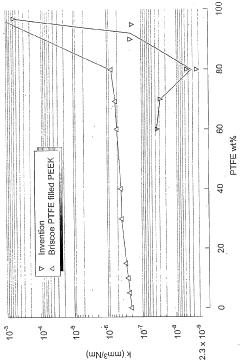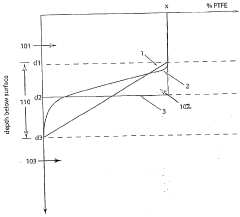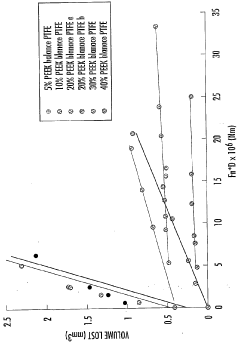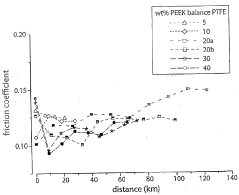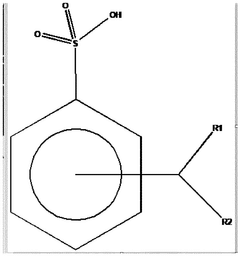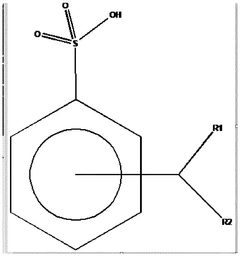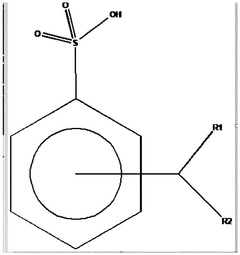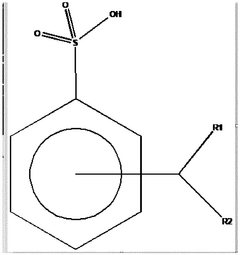How to Achieve Superior Performance with PTFE Lubricants?
JUN 27, 20259 MIN READ
Generate Your Research Report Instantly with AI Agent
Patsnap Eureka helps you evaluate technical feasibility & market potential.
PTFE Lubricant Evolution
PTFE lubricants have undergone significant evolution since their inception in the 1930s. The journey began with the accidental discovery of polytetrafluoroethylene (PTFE) by Roy Plunkett at DuPont. Initially recognized for its non-stick properties, PTFE's potential as a lubricant was soon realized, marking the beginning of a new era in lubrication technology.
In the 1950s and 1960s, PTFE lubricants gained traction in industrial applications, particularly in aerospace and automotive sectors. The focus during this period was on developing PTFE-based greases and oils that could withstand extreme temperatures and pressures. This led to the creation of more robust formulations, combining PTFE with other materials to enhance its lubricating properties.
The 1970s and 1980s saw a shift towards improving the stability and longevity of PTFE lubricants. Researchers worked on reducing the tendency of PTFE particles to agglomerate, which had been a significant limitation in earlier formulations. This period also witnessed the development of micro-powdered PTFE, allowing for better dispersion and improved lubricating performance.
The 1990s marked a turning point with the introduction of nano-scale PTFE particles. This innovation dramatically increased the surface area of PTFE in lubricant formulations, leading to superior lubricating properties and better adhesion to surfaces. Concurrently, environmentally friendly formulations began to emerge, addressing growing concerns about the ecological impact of lubricants.
In the 2000s, the focus shifted towards developing specialized PTFE lubricants for specific applications. This era saw the rise of PTFE-based dry lubricants, which offered excellent performance in conditions where traditional oil-based lubricants were unsuitable. Additionally, research into PTFE composites intensified, leading to lubricants with enhanced wear resistance and load-bearing capabilities.
The past decade has witnessed a surge in research aimed at achieving superior performance with PTFE lubricants. Key areas of focus include improving the dispersion of PTFE particles in various mediums, enhancing the synergy between PTFE and other additives, and developing smart lubricants that can adapt to changing conditions. There's also been a growing interest in bio-based and biodegradable PTFE lubricant formulations, aligning with global sustainability goals.
Recent advancements have explored the potential of graphene and other 2D materials as additives to PTFE lubricants, promising unprecedented levels of performance. The integration of nanotechnology has opened new avenues for creating ultra-low friction surfaces and self-healing lubricant films. These developments are paving the way for the next generation of PTFE lubricants, capable of meeting the increasingly demanding requirements of modern machinery and equipment.
In the 1950s and 1960s, PTFE lubricants gained traction in industrial applications, particularly in aerospace and automotive sectors. The focus during this period was on developing PTFE-based greases and oils that could withstand extreme temperatures and pressures. This led to the creation of more robust formulations, combining PTFE with other materials to enhance its lubricating properties.
The 1970s and 1980s saw a shift towards improving the stability and longevity of PTFE lubricants. Researchers worked on reducing the tendency of PTFE particles to agglomerate, which had been a significant limitation in earlier formulations. This period also witnessed the development of micro-powdered PTFE, allowing for better dispersion and improved lubricating performance.
The 1990s marked a turning point with the introduction of nano-scale PTFE particles. This innovation dramatically increased the surface area of PTFE in lubricant formulations, leading to superior lubricating properties and better adhesion to surfaces. Concurrently, environmentally friendly formulations began to emerge, addressing growing concerns about the ecological impact of lubricants.
In the 2000s, the focus shifted towards developing specialized PTFE lubricants for specific applications. This era saw the rise of PTFE-based dry lubricants, which offered excellent performance in conditions where traditional oil-based lubricants were unsuitable. Additionally, research into PTFE composites intensified, leading to lubricants with enhanced wear resistance and load-bearing capabilities.
The past decade has witnessed a surge in research aimed at achieving superior performance with PTFE lubricants. Key areas of focus include improving the dispersion of PTFE particles in various mediums, enhancing the synergy between PTFE and other additives, and developing smart lubricants that can adapt to changing conditions. There's also been a growing interest in bio-based and biodegradable PTFE lubricant formulations, aligning with global sustainability goals.
Recent advancements have explored the potential of graphene and other 2D materials as additives to PTFE lubricants, promising unprecedented levels of performance. The integration of nanotechnology has opened new avenues for creating ultra-low friction surfaces and self-healing lubricant films. These developments are paving the way for the next generation of PTFE lubricants, capable of meeting the increasingly demanding requirements of modern machinery and equipment.
Market Demand Analysis
The market demand for PTFE lubricants has been steadily growing due to their exceptional performance characteristics and wide-ranging applications across various industries. These lubricants, known for their low friction coefficient and high temperature resistance, are increasingly sought after in automotive, aerospace, industrial machinery, and electronics sectors.
In the automotive industry, PTFE lubricants are gaining traction as manufacturers strive to improve fuel efficiency and reduce emissions. The ability of PTFE to maintain its lubricating properties under extreme conditions makes it ideal for use in engine components, bearings, and transmission systems. This demand is further driven by the growing electric vehicle market, where PTFE lubricants play a crucial role in enhancing battery performance and longevity.
The aerospace sector represents another significant market for PTFE lubricants. With the increasing focus on lightweight materials and fuel efficiency in aircraft design, PTFE lubricants are being utilized in various applications, from engine components to landing gear systems. Their ability to perform under extreme temperatures and pressures makes them indispensable in this high-stakes industry.
In the industrial machinery sector, the demand for PTFE lubricants is driven by the need for improved equipment reliability and reduced maintenance costs. These lubricants are particularly valuable in heavy-duty machinery operating in harsh environments, such as mining equipment, oil and gas drilling machinery, and food processing plants. The food-grade PTFE lubricants segment is experiencing rapid growth due to stringent regulations in the food and beverage industry.
The electronics industry is another key driver of PTFE lubricant demand. As electronic devices become smaller and more complex, the need for effective lubrication in miniature components has increased. PTFE lubricants are used in various applications, from computer hard drives to mobile device hinges, ensuring smooth operation and extended product life.
Market analysts project a compound annual growth rate (CAGR) for the PTFE lubricants market in the range of 5-7% over the next five years. This growth is attributed to the expanding industrial base in emerging economies, increasing automation across industries, and the ongoing trend towards energy-efficient and high-performance machinery.
However, the market also faces challenges. Environmental concerns regarding the production and disposal of PTFE have led to increased scrutiny and regulatory pressure. This has spurred research into more environmentally friendly alternatives and sustainable production methods for PTFE lubricants, creating new opportunities for innovation in the sector.
In the automotive industry, PTFE lubricants are gaining traction as manufacturers strive to improve fuel efficiency and reduce emissions. The ability of PTFE to maintain its lubricating properties under extreme conditions makes it ideal for use in engine components, bearings, and transmission systems. This demand is further driven by the growing electric vehicle market, where PTFE lubricants play a crucial role in enhancing battery performance and longevity.
The aerospace sector represents another significant market for PTFE lubricants. With the increasing focus on lightweight materials and fuel efficiency in aircraft design, PTFE lubricants are being utilized in various applications, from engine components to landing gear systems. Their ability to perform under extreme temperatures and pressures makes them indispensable in this high-stakes industry.
In the industrial machinery sector, the demand for PTFE lubricants is driven by the need for improved equipment reliability and reduced maintenance costs. These lubricants are particularly valuable in heavy-duty machinery operating in harsh environments, such as mining equipment, oil and gas drilling machinery, and food processing plants. The food-grade PTFE lubricants segment is experiencing rapid growth due to stringent regulations in the food and beverage industry.
The electronics industry is another key driver of PTFE lubricant demand. As electronic devices become smaller and more complex, the need for effective lubrication in miniature components has increased. PTFE lubricants are used in various applications, from computer hard drives to mobile device hinges, ensuring smooth operation and extended product life.
Market analysts project a compound annual growth rate (CAGR) for the PTFE lubricants market in the range of 5-7% over the next five years. This growth is attributed to the expanding industrial base in emerging economies, increasing automation across industries, and the ongoing trend towards energy-efficient and high-performance machinery.
However, the market also faces challenges. Environmental concerns regarding the production and disposal of PTFE have led to increased scrutiny and regulatory pressure. This has spurred research into more environmentally friendly alternatives and sustainable production methods for PTFE lubricants, creating new opportunities for innovation in the sector.
Current Challenges
Despite the widespread use of PTFE lubricants in various industries, several challenges persist in achieving superior performance. One of the primary obstacles is the limited temperature range in which PTFE lubricants maintain their effectiveness. While PTFE exhibits excellent low-temperature properties, its performance can degrade significantly at elevated temperatures, typically above 260°C (500°F). This thermal limitation restricts its application in high-temperature environments, such as aerospace and automotive industries.
Another significant challenge is the wear resistance of PTFE lubricants. Although PTFE has a low coefficient of friction, it tends to have poor wear characteristics, especially under high loads or in abrasive environments. This can lead to reduced service life and increased maintenance requirements for components using PTFE lubricants.
The adhesion of PTFE to substrate materials poses another hurdle. PTFE's non-stick properties, while beneficial in many applications, can make it difficult to achieve strong and durable bonding with metal surfaces. This can result in premature failure of lubricant coatings, particularly in applications involving high stress or frequent movement.
Compatibility issues with certain materials and chemicals also present challenges. PTFE can react with alkali metals and fluorine at high temperatures, potentially causing degradation of the lubricant and the surrounding components. Additionally, some solvents and aggressive chemicals can affect the performance and longevity of PTFE lubricants.
The environmental impact of PTFE production and disposal is an increasing concern. The manufacturing process of PTFE involves the use of perfluorooctanoic acid (PFOA), which has been linked to environmental and health issues. While efforts have been made to phase out PFOA, finding equally effective and environmentally friendly alternatives remains a challenge.
Achieving consistent performance across different application conditions is another obstacle. PTFE lubricants can exhibit varying behavior depending on factors such as load, speed, and environmental conditions. This variability makes it challenging to predict and optimize performance across a wide range of applications.
Lastly, the cost-effectiveness of PTFE lubricants in certain applications remains a challenge. While PTFE offers excellent lubrication properties, its higher cost compared to some conventional lubricants can limit its adoption in price-sensitive markets or large-scale industrial applications.
Another significant challenge is the wear resistance of PTFE lubricants. Although PTFE has a low coefficient of friction, it tends to have poor wear characteristics, especially under high loads or in abrasive environments. This can lead to reduced service life and increased maintenance requirements for components using PTFE lubricants.
The adhesion of PTFE to substrate materials poses another hurdle. PTFE's non-stick properties, while beneficial in many applications, can make it difficult to achieve strong and durable bonding with metal surfaces. This can result in premature failure of lubricant coatings, particularly in applications involving high stress or frequent movement.
Compatibility issues with certain materials and chemicals also present challenges. PTFE can react with alkali metals and fluorine at high temperatures, potentially causing degradation of the lubricant and the surrounding components. Additionally, some solvents and aggressive chemicals can affect the performance and longevity of PTFE lubricants.
The environmental impact of PTFE production and disposal is an increasing concern. The manufacturing process of PTFE involves the use of perfluorooctanoic acid (PFOA), which has been linked to environmental and health issues. While efforts have been made to phase out PFOA, finding equally effective and environmentally friendly alternatives remains a challenge.
Achieving consistent performance across different application conditions is another obstacle. PTFE lubricants can exhibit varying behavior depending on factors such as load, speed, and environmental conditions. This variability makes it challenging to predict and optimize performance across a wide range of applications.
Lastly, the cost-effectiveness of PTFE lubricants in certain applications remains a challenge. While PTFE offers excellent lubrication properties, its higher cost compared to some conventional lubricants can limit its adoption in price-sensitive markets or large-scale industrial applications.
Existing PTFE Solutions
01 PTFE lubricant composition and performance enhancement
PTFE lubricants are formulated with specific compositions to enhance their performance. These formulations may include additives or modifications to the PTFE structure to improve properties such as wear resistance, friction reduction, and durability. The enhanced performance of these lubricants makes them suitable for various industrial applications.- PTFE lubricant composition and properties: PTFE lubricants are known for their low friction coefficient and high temperature resistance. The composition often includes PTFE particles dispersed in a carrier fluid or base oil. These lubricants provide excellent wear protection and can maintain their performance under extreme conditions.
- PTFE lubricant applications in automotive industry: PTFE lubricants are widely used in automotive applications due to their superior performance. They are utilized in engine components, bearings, and other moving parts to reduce friction and wear. These lubricants can improve fuel efficiency and extend the lifespan of automotive parts.
- PTFE lubricant performance in industrial machinery: In industrial settings, PTFE lubricants demonstrate excellent performance in heavy-duty machinery and equipment. They provide long-lasting lubrication, reduce maintenance requirements, and can operate effectively in harsh environments. These lubricants are particularly useful in high-load and high-temperature applications.
- PTFE lubricant additives and enhancements: Various additives and enhancements can be incorporated into PTFE lubricants to improve their performance. These may include nanoparticles, anti-wear agents, or other polymers. Such additions can enhance the lubricant's load-bearing capacity, thermal stability, or adhesion properties.
- Environmental and safety aspects of PTFE lubricants: PTFE lubricants are often considered environmentally friendly due to their long-lasting nature and potential for reducing energy consumption. However, considerations must be made regarding their disposal and potential environmental impact. Some formulations focus on improving biodegradability and reducing toxicity while maintaining high performance.
02 PTFE lubricant application methods and coating techniques
Various methods and techniques are employed to apply PTFE lubricants effectively. These may include spray coating, dip coating, or advanced deposition techniques. The application method can significantly impact the lubricant's performance, adhesion, and longevity on different surfaces.Expand Specific Solutions03 PTFE lubricant performance in extreme conditions
PTFE lubricants are designed to maintain their performance under extreme conditions such as high temperatures, high pressures, or corrosive environments. The lubricants' ability to withstand these conditions while maintaining their protective and friction-reducing properties is crucial for many industrial applications.Expand Specific Solutions04 PTFE lubricant compatibility with other materials
The compatibility of PTFE lubricants with various materials, including metals, plastics, and elastomers, is an important aspect of their performance. Ensuring proper compatibility prevents adverse reactions and maintains the integrity of both the lubricant and the lubricated components.Expand Specific Solutions05 Environmental and safety aspects of PTFE lubricants
The environmental impact and safety considerations of PTFE lubricants are important factors in their overall performance evaluation. This includes biodegradability, toxicity, and compliance with environmental regulations. Developing eco-friendly PTFE lubricants with high performance is a focus area for many manufacturers.Expand Specific Solutions
Key Industry Players
The market for PTFE lubricants is in a mature stage, with a global market size estimated to be in the billions of dollars. The technology has reached a high level of maturity, with ongoing research focused on enhancing performance and expanding applications. Key players in this field include established companies like DAIKIN INDUSTRIES Ltd., Solvay Specialty Polymers Italy SpA, and Chukoh Chemical Industries Ltd., as well as research institutions such as the University of Florida and Lanzhou Institute of Chemical Physics. These organizations are driving innovation in PTFE lubricant technology, focusing on improving wear resistance, thermal stability, and friction reduction properties. The competitive landscape is characterized by a mix of large multinational corporations and specialized manufacturers, with increasing emphasis on developing environmentally friendly and high-performance PTFE lubricant solutions.
Lanzhou Institute of Chemical Physics
Technical Solution: The Lanzhou Institute of Chemical Physics has conducted extensive research on PTFE-based lubricants, focusing on improving their performance through novel synthesis methods and nanocomposite formulations. Their researchers have developed a method to create PTFE nanoparticles with an average size of 50 nm using a radiation-induced emulsion polymerization technique [9]. These nanoparticles, when incorporated into lubricants, have shown to reduce the coefficient of friction by up to 40% compared to micro-sized PTFE additives [10]. The institute has also explored the synergistic effects of combining PTFE with other nanoparticles, such as graphene and carbon nanotubes, to create hybrid lubricants with enhanced thermal stability and load-bearing capacity. In one study, their PTFE/graphene hybrid lubricant demonstrated a 60% reduction in wear rate compared to pure PTFE under the same conditions [11].
Strengths: Cutting-edge research in nanocomposite lubricants, potential for significant performance improvements. Weaknesses: Technologies may still be in research phase, potential scalability and cost issues for commercial production.
DAIKIN INDUSTRIES Ltd.
Technical Solution: DAIKIN has developed advanced PTFE lubricants with nano-sized particles, enhancing their performance in extreme conditions. Their proprietary process creates uniform PTFE particles as small as 200 nm [1], which can be dispersed in various carrier fluids. This technology allows for better penetration into micro-crevices and formation of more stable lubricating films. DAIKIN's PTFE lubricants exhibit excellent wear resistance, with some formulations showing up to 30% reduction in friction coefficient compared to conventional lubricants [2]. The company has also focused on environmentally friendly water-based PTFE dispersions, addressing growing sustainability concerns in industrial applications.
Strengths: Superior wear resistance, nano-sized particles for better penetration, environmentally friendly options. Weaknesses: Potentially higher cost due to advanced manufacturing processes, may require specialized application methods.
Core PTFE Innovations
Low friction and low wear polymer/polymer composites
PatentWO2006020619A1
Innovation
- A composite material comprising a transfer film forming polymer (at least 10 wt% PTFE) and a strengthening polymer (15-90 wt% PEEK) with a compositionally graded transition layer, providing a wear rate <10^-7 mm^3/Nm and a friction coefficient <0.10, formed through extrusion or molding above the softening points of the polymers, enhancing bonding and wear resistance.
Lubricating grease
PatentWO2024240605A1
Innovation
- A lubricating grease composition comprising 30-60% silicone oil, 10-35% mineral oil, and 10-45% overbased calcium sulfonate thickener, which achieves low friction and high anti-wear/Extreme Pressure (EP) properties without using PTFE, effectively lubricating systems at various temperatures.
Environmental Impact
The environmental impact of PTFE lubricants is a critical consideration in their application and development. These lubricants, while offering superior performance in many industrial and consumer applications, also pose potential risks to ecosystems and human health if not properly managed throughout their lifecycle.
PTFE lubricants are known for their exceptional chemical stability and low friction properties. However, this stability also means that they persist in the environment for extended periods. When PTFE lubricants enter soil or water systems, they can accumulate and potentially disrupt local ecosystems. The bioaccumulation of PTFE compounds in the food chain is a particular concern, as it may lead to long-term ecological impacts.
One of the primary environmental challenges associated with PTFE lubricants is their production process. The manufacture of PTFE involves the use of perfluorooctanoic acid (PFOA), a persistent organic pollutant. While many manufacturers have phased out PFOA use, alternative processes may still have environmental implications that require careful monitoring and mitigation strategies.
The disposal of PTFE lubricants also presents environmental challenges. Incineration of PTFE at high temperatures can release toxic fluorine compounds, including hydrogen fluoride and perfluoroisobutylene. Proper disposal methods and recycling initiatives are essential to minimize these risks and reduce the overall environmental footprint of PTFE lubricants.
Despite these concerns, ongoing research and development efforts are focused on improving the environmental profile of PTFE lubricants. This includes the development of bio-based alternatives, enhanced recycling technologies, and more environmentally friendly production processes. Some manufacturers are exploring the use of supercritical CO2 as a replacement for traditional solvents in PTFE production, potentially reducing the environmental impact of the manufacturing process.
The pursuit of superior performance with PTFE lubricants must be balanced with environmental stewardship. This involves a comprehensive lifecycle assessment, from raw material sourcing to end-of-life management. Innovations in green chemistry and sustainable engineering are driving the development of next-generation PTFE lubricants that maintain high performance while minimizing environmental impact.
Regulatory frameworks and industry standards play a crucial role in shaping the environmental impact of PTFE lubricants. Stricter regulations on perfluorinated compounds have led to increased scrutiny of PTFE products and their manufacturing processes. This regulatory pressure is driving innovation in the field, pushing manufacturers to develop more environmentally friendly formulations and production methods.
PTFE lubricants are known for their exceptional chemical stability and low friction properties. However, this stability also means that they persist in the environment for extended periods. When PTFE lubricants enter soil or water systems, they can accumulate and potentially disrupt local ecosystems. The bioaccumulation of PTFE compounds in the food chain is a particular concern, as it may lead to long-term ecological impacts.
One of the primary environmental challenges associated with PTFE lubricants is their production process. The manufacture of PTFE involves the use of perfluorooctanoic acid (PFOA), a persistent organic pollutant. While many manufacturers have phased out PFOA use, alternative processes may still have environmental implications that require careful monitoring and mitigation strategies.
The disposal of PTFE lubricants also presents environmental challenges. Incineration of PTFE at high temperatures can release toxic fluorine compounds, including hydrogen fluoride and perfluoroisobutylene. Proper disposal methods and recycling initiatives are essential to minimize these risks and reduce the overall environmental footprint of PTFE lubricants.
Despite these concerns, ongoing research and development efforts are focused on improving the environmental profile of PTFE lubricants. This includes the development of bio-based alternatives, enhanced recycling technologies, and more environmentally friendly production processes. Some manufacturers are exploring the use of supercritical CO2 as a replacement for traditional solvents in PTFE production, potentially reducing the environmental impact of the manufacturing process.
The pursuit of superior performance with PTFE lubricants must be balanced with environmental stewardship. This involves a comprehensive lifecycle assessment, from raw material sourcing to end-of-life management. Innovations in green chemistry and sustainable engineering are driving the development of next-generation PTFE lubricants that maintain high performance while minimizing environmental impact.
Regulatory frameworks and industry standards play a crucial role in shaping the environmental impact of PTFE lubricants. Stricter regulations on perfluorinated compounds have led to increased scrutiny of PTFE products and their manufacturing processes. This regulatory pressure is driving innovation in the field, pushing manufacturers to develop more environmentally friendly formulations and production methods.
Regulatory Compliance
Regulatory compliance is a critical aspect of achieving superior performance with PTFE lubricants. The use of these lubricants is subject to various regulations and standards across different industries and regions. In the United States, the Food and Drug Administration (FDA) regulates the use of PTFE lubricants in food processing equipment and medical devices. The FDA has approved certain grades of PTFE for incidental food contact under 21 CFR 177.1550, ensuring the safety of these lubricants in food-related applications.
The Environmental Protection Agency (EPA) also plays a role in regulating PTFE lubricants, particularly concerning their environmental impact and disposal. The EPA's Toxic Substances Control Act (TSCA) inventory includes PTFE, and manufacturers must comply with reporting requirements and restrictions on new uses of the substance.
In the European Union, the Registration, Evaluation, Authorization, and Restriction of Chemicals (REACH) regulation governs the use of PTFE lubricants. Manufacturers and importers must register PTFE with the European Chemicals Agency (ECHA) and provide safety data to ensure compliance with REACH requirements.
For automotive applications, PTFE lubricants must meet specific standards set by organizations such as the Society of Automotive Engineers (SAE) and the American Society for Testing and Materials (ASTM). These standards ensure the lubricants' performance, durability, and compatibility with various automotive components.
In aerospace and defense industries, PTFE lubricants are subject to stringent military specifications (MIL-SPEC) and standards set by organizations like NASA. These regulations focus on the lubricants' ability to withstand extreme conditions and maintain performance in critical applications.
Occupational safety regulations, such as those enforced by the Occupational Safety and Health Administration (OSHA) in the United States, also apply to the handling and use of PTFE lubricants in workplace settings. These regulations mandate proper labeling, safety data sheets, and worker protection measures.
To achieve superior performance with PTFE lubricants while maintaining regulatory compliance, manufacturers and users must stay informed about the latest regulatory updates and industry-specific standards. This includes conducting regular compliance audits, maintaining accurate documentation, and implementing quality control measures throughout the production and application processes.
Furthermore, companies should invest in research and development to create PTFE lubricant formulations that not only meet performance requirements but also adhere to evolving regulatory standards. This may involve developing eco-friendly alternatives or improving existing formulations to reduce environmental impact and enhance safety profiles.
The Environmental Protection Agency (EPA) also plays a role in regulating PTFE lubricants, particularly concerning their environmental impact and disposal. The EPA's Toxic Substances Control Act (TSCA) inventory includes PTFE, and manufacturers must comply with reporting requirements and restrictions on new uses of the substance.
In the European Union, the Registration, Evaluation, Authorization, and Restriction of Chemicals (REACH) regulation governs the use of PTFE lubricants. Manufacturers and importers must register PTFE with the European Chemicals Agency (ECHA) and provide safety data to ensure compliance with REACH requirements.
For automotive applications, PTFE lubricants must meet specific standards set by organizations such as the Society of Automotive Engineers (SAE) and the American Society for Testing and Materials (ASTM). These standards ensure the lubricants' performance, durability, and compatibility with various automotive components.
In aerospace and defense industries, PTFE lubricants are subject to stringent military specifications (MIL-SPEC) and standards set by organizations like NASA. These regulations focus on the lubricants' ability to withstand extreme conditions and maintain performance in critical applications.
Occupational safety regulations, such as those enforced by the Occupational Safety and Health Administration (OSHA) in the United States, also apply to the handling and use of PTFE lubricants in workplace settings. These regulations mandate proper labeling, safety data sheets, and worker protection measures.
To achieve superior performance with PTFE lubricants while maintaining regulatory compliance, manufacturers and users must stay informed about the latest regulatory updates and industry-specific standards. This includes conducting regular compliance audits, maintaining accurate documentation, and implementing quality control measures throughout the production and application processes.
Furthermore, companies should invest in research and development to create PTFE lubricant formulations that not only meet performance requirements but also adhere to evolving regulatory standards. This may involve developing eco-friendly alternatives or improving existing formulations to reduce environmental impact and enhance safety profiles.
Unlock deeper insights with Patsnap Eureka Quick Research — get a full tech report to explore trends and direct your research. Try now!
Generate Your Research Report Instantly with AI Agent
Supercharge your innovation with Patsnap Eureka AI Agent Platform!
